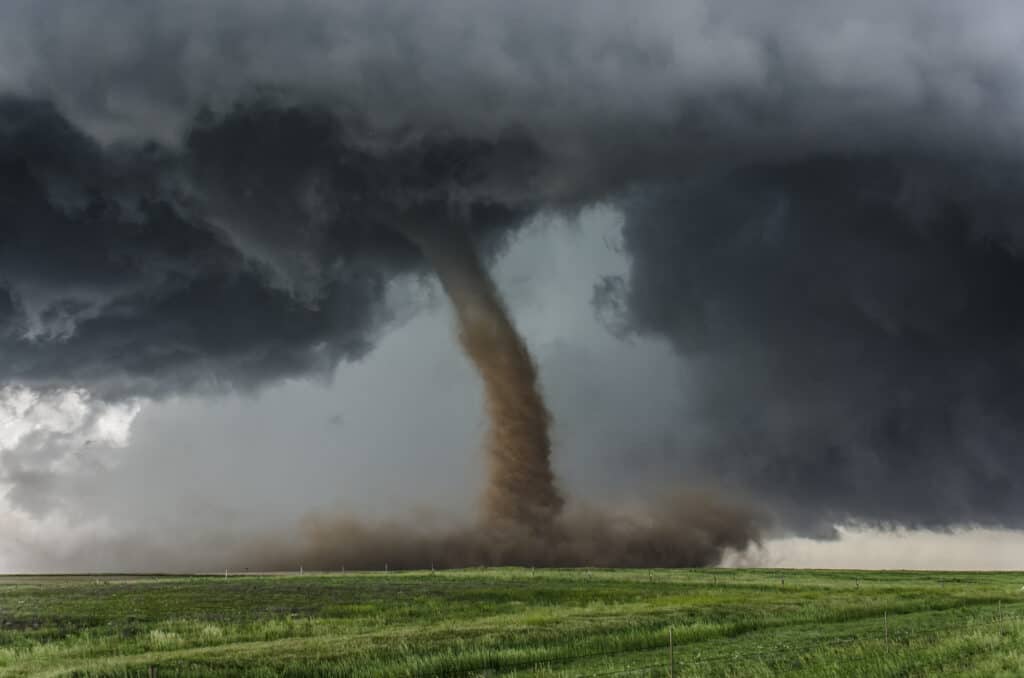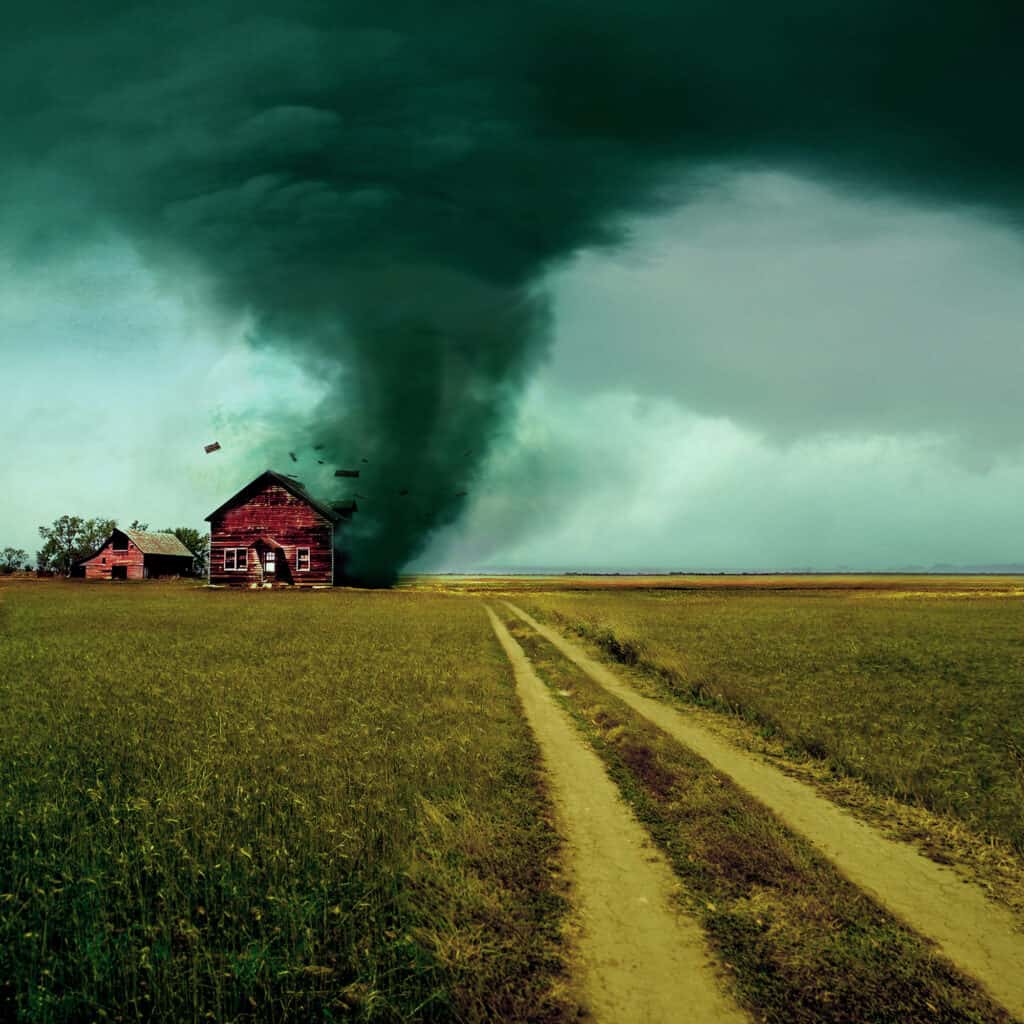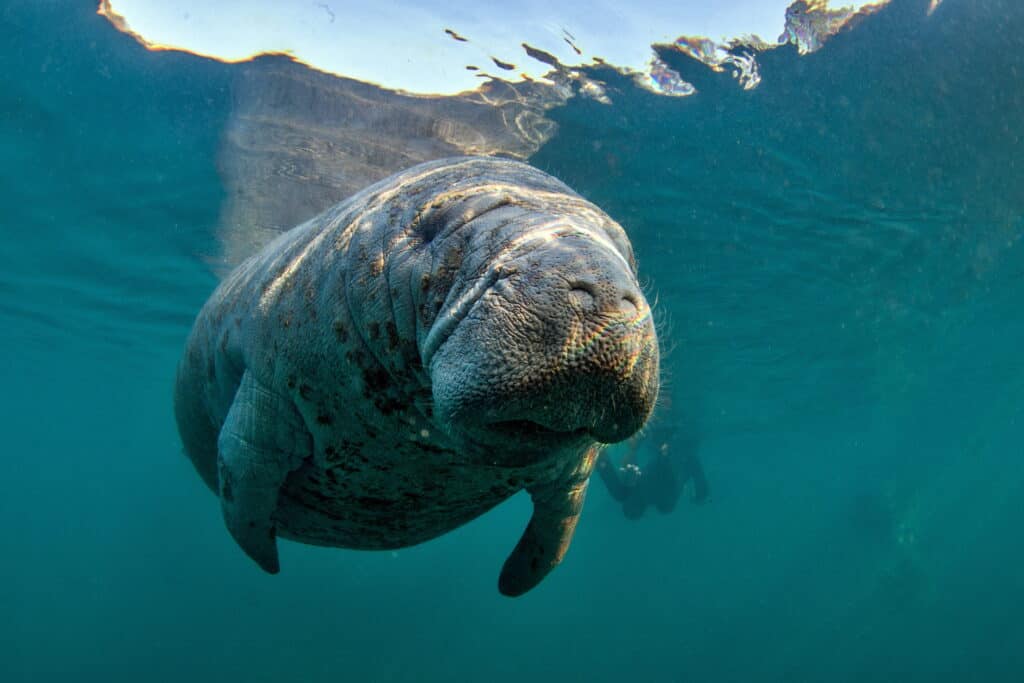Tornados refer to columns of air that rotate violently, resulting in a severe storm. They are some of the most violent natural storms, appearing suddenly with winds of up to 250 mph. Most tornadoes occur along Tornado Alley, an area encompassing Kansas, Nebraska, Oklahoma, and Northern Texas. However, tornadoes also occur in other states, such as Florida. Read along, as we uncover the Florida town most likely to be hit by a tornado!

Tornadoes in Florida mostly occur in the inland regions.
©Minerva Studio/Shutterstock.com
Statistics show that Tennessee is often the state hit with the worst tornadoes. This southern state can register up to 72 tornadoes daily during peak seasons. Oklahoma follows closely, with 70 storms touching the ground daily. But other states, like Florida, are not left behind when it comes to tornadoes.
The Florida tornado index is 185.89, according to the U.S. weather index ranking. Compared to places like Tennessee, where the tornado index is 208.58, Florida’s tornadoes are mild. However, the Sunshine State’s score is still high enough to warrant concern.
Tornadoes in Orlando, Florida
While Florida is better known for hurricanes, it’s no stranger to tornadoes. Tornadoes in Florida are most likely to occur in the inland regions, close to Orlando.
Orlando is popular as the home of numerous theme parks. Fortunately, these midland tornadoes are pretty mild. However, waterspouts may occur when close to the ocean.
Where is the Florida City Most Likely to be Hit by a Tornado Located on a Map?
Orlando and surrounding areas are where a tornado in Florida is most likely to occur. Orlando is located inland, in central Florida, in close proximity to Daytona Beach to the northeast and Tampa to the southwest. Orlando is home to more than a dozen theme parks – including Disney World.
History of Tornadoes in Florida
Most tornadoes in Florida occur in the spring or summer, with the strongest ones hitting in the spring.
They often occur along the coast, near Tampa Bay and Fort Myers. These two areas continually record higher incidences of tornadoes. The Atlantic Coast and the Western Panhandle are also sometimes affected.
Usually, tornadoes in Florida tend to form:
- Within a hurricane
- Before an advancing cold front
- From isolated summer thunderstorms
- Along squall lines in regions with masses of warm air
The causes and triggers of tornadoes remain unclear today. Meteorologists cannot pinpoint the actual causes of tornadoes. However, they can identify atmospheric conditions that often precede them. This is how they predict possible tornadoes and relay warnings to residents.
Unfortunately, the intensity of a tornado is only measurable after its occurrence, when experts and surveyors from the National Weather Service assess the structural damage.
The tornado categorization is based on the intensity. Once the survey ends, findings go on the Fujita scale. Over time, this scale has improved. It now accommodates intensity measurement even when there are no structural damages.
History of Significant Tornadoes in Florida

Many F3 tornadoes have hit Florida, shredding homes and taking lives.
©EmiliaUngur/Shutterstock.com
Only by examining past tornadoes can we truly appreciate the impact of the storms. Below, we list a few tornadoes in Florida’s history:
February 22, 1998
This remains one of the deadliest tornadoes in Florida. It was a category F3 outbreak. Initially, the tornado touched down 1 mile south of the city intersection. It then moved northeast at a speed of 45 mph before ripping through Kissimmee.
It was such a severe storm that 25 people died, and lots of property destruction occurred.
Some areas were hit worse than others, like Morningside Acres mobile home community and the Ponderosa Recreational vehicle park.
Of those killed, eight were in recreational vehicles, 15 were in mobile homes, and one was in a vehicle. The tornado moved to the northeastern area, reaching Orange County, 6 miles north of St. Cloud.
Overall, more than 150 people were injured and hundreds of structures were destroyed.
March 31, 1962
This F3 tornado hit shortly after 9 am. It cleared an eight-mile path through Santa Rosa County, with Milton seeing the worst damage. Across a six-block region, 130 homes were destroyed. There was also severe damage to a mobile home park. This tornado caused 17 deaths and 100 injuries.
February 22, 1998
This F3 storm touched down close to Longwood, before moving northeast at 45 mph. The tornado passed through neighborhoods in southeast Sanford, killing a total of 13 people and injuring 70.
The tornado continued further northeast, moving into Volusia County, five miles east of Sanford. Wind speeds were 200 mph, which was strong enough to decimate over 625 structures.
February 2, 2007
This was an F3 storm that re-intensified after the Lady Lake tornado. This time, the tornado swept through rural Florida, southwest of Paisley.
It moved northeast at 50mph toward the Lake Mack region, west of St. Johns River. This storm produced a quarter-mile-wide track over Lack Mack. Over 86 homes were destroyed, and 144 homes were damaged. The storm left 13 people dead and 51 injured.
April 4, 1966
This F4 storm started close to the Clearwater area. It later moved toward North Tampa via Carrollwood and Temple Terrace. It bulldozed its way through Gibsonia, Campbell City, Loughman, and Merritt Island. Many houses and businesses were destroyed. The storm left 11 dead and 530 people injured.
February 2, 2007
This tornado first touched down around the southeast corner of Village South Lake Miona. It quickly moved northeast at 55 mph toward Lake County.
The six-minute-long tornado left massive destruction. According to the Fema report, over 1,145 homes were damaged and 200 more were flattened. It left eight dead and 25 injured. Notably, all deaths occurred in mobile homes.
April 19, 1988
The F3 storm began near Madison. Four people died, and 18 were injured.
The storm left a path of destruction, flattening over 30 homes. Some commercial buildings were also destroyed. The North Florida Junior College was among the worst hit.
May 4, 1994
This storm affected the High Point section of northeastern Pinellas County. It left three dead and 94 injured. Of the most affected was High Point Elementary, where several classrooms were torn apart, killing three people. Teachers and students were buried under debris.
February 7, 1971
This was a predawn F3 storm that caused over 100 injuries. Luckily, there were no fatalities. The damage was most noticeable in the high-end apartment complex, Gulf Breeze.
June 17, 1959
This tornado first touched down in Coral Gables. Afterward, it moved to the Miami business district and Biscayne Bay. The impact was widespread, stretching to Sunny Isle.
How do Florida Tornadoes Impact Wildlife?
Tornadoes have a wide-reaching impact on communities. Property is lost and livelihoods are greatly affected. In some instances, lives are lost. Unfortunately, humans aren’t the only ones impacted by these powerful storms.
Tornadoes Affect Wildlife

The Florida manatee can become trapped inland when the flood waters recede.
©Tomas Kotouc/Shutterstock.com
Naturally, animals have unique adaptations that help them survive natural calamities. For example, sea animals change their breeding habits. Most of them breed around these storm seasons, with their eggs hatching before hurricane season. This increases the chances of survival.
Unfortunately, humans have interfered with animals’ ability to endure such harsh storms. For example, most animal species have been pushed to a limited habitat due to human settlement. This means populations decline over time as it becomes difficult to bounce back after a storm.
Some storms can easily wipe out animal habitats on land and at sea. Additionally, some animals get trapped in the wrong habitat. For instance, the Florida manatee can become trapped inland when the flood waters recede.
The Florida Fish and Wildlife Conservation Commission asked people to report cases of misplaced wildlife. Some species that survive the storm can be relocated to their natural habitats. It is advisable not to attempt to rescue wildlife during or after the storm. Report these cases to the relevant authorities. They have the right tools and skills to execute such rescues.
Fortunately, most animals will repopulate soon after a tornado, and those that migrated come back. For example, most birds leave before a tornado and return when things settle down.
On the other hand, some wildlife species may benefit from the storm’s impact. For example, the landscape changes after a storm can be suitable for some species. For instance, owls tend to benefit from increased preferred habitats, which emerge due to drowned woody debris, newly created snags, and brush piles.
Captive Animals May Escape
Such storms may also lead to the escape of captive pet animals. There have been cases of python snakes escaping their enclosures after tornadoes. It is advisable to report spotted non-native species near you.
Additionally, invasive species may spread to other areas after a storm. The wind and rainwater may also spread spores and seeds of invasive species. Consequently, this creates new infestations.
Aquatic Ecosystems Changes
Aquatic ecosystems also change. The increase in water level and erosion can negatively affect plant life. This happens in both freshwater and saltwater sources.
Thank you for reading! Have some feedback for us? Contact the AZ Animals editorial team.








